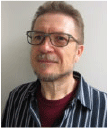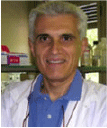Articles citing this paper
Tellurite-dependent blackening of bacteria emerges from the dark ages
Alessandro Presentato A , Raymond J. Turner B F , Claudio C. Vásquez C , Vladimir Yurkov D and Davide Zannoni E
+ Author Affiliations
- Author Affiliations
A Department of Biotechnology, University of Verona, Verona, 37134, Italy.
B Department of Biological Sciences, University of Calgary, Calgary, AB T2N 1N4, Canada.
C Facultad de Química y Biología, Universidad de Santiago de Chile, Santiago, Chile.
D Department of Microbiology, University of Manitoba, Winnipeg, MB R3T 2N2, Canada.
E Unit of General and Applied Microbiology, Department of Pharmacy and Biotechnology, University of Bologna, Bologna, 40126, Italy.
F Corresponding author. Email: turnerr@ucalgary.ca

Dr Alessandro Presentato received his BS degree in Biological Sciences from the University of Palermo (Italy) in 2008, and his MS degree in Cellular and Molecular Biology from the University of Palermo in 2011. Then, he joined the Department of Pharmacy and Biotechnology of the University of Bologna as graduate student and obtained his PhD in Cellular and Molecular Biology under the supervision of Professor Davide Zannoni in 2015. Subsequently, he worked as a Post-Doctoral Fellow in the Microbial Biochemistry group of Professor Raymond J. Turner at the University of Calgary (Canada) between 2015 and 2017. He is currently working as a Post-Doctoral Fellow in Professor Giovanni Vallini’s research group (Environmental Microbiology and Microbial Biotechnology) at the University of Verona (Italy). His research is focused on (2) the study of biogenic nanomaterials made of elemental selenium and/or tellurium and their potential applications in biotechnology and (2) the study of microorganisms as catalysts for the biotic degradation of per- and poly-fluoroalkyl compounds.
|

Raymond J. Turner joined the University of Calgary in 1998 in the Department of Biological Sciences and is presently a Professor of Biochemistry and Microbiology (full professor since 2006). His PhD is in Biophysical Chemistry and he is a postdoctoral fellow in the area of antimicrobial resistance and bioenergetics at the University of Alberta. He has held the post of Associate Department Head and Graduate Program Director from 2013 to 2017. He has also been chair of various research cluster units over the past 10 years. He has held funding from the Canadian funding councils of NSERC, CIHR, Genome Canada and MITACS as well as industrial partners, and has received excellence in research and excellence in graduate student supervision awards. Professor Turner’s research interests are multi-disciplinary: bioinorganic and environmental chemistry of chalcogen metals, metal toxicity and resistance mechanism towards bacteria, the microbiology of metal nanoparticles, biofilm physiology and biochemistry, membrane protein structural biology, multidrug resistance transporters, protein chaperones for complex iron sulphur molybdoenzymes that use the twin arginine translocase and the photochemistry of novel fluorophores. He has contributed between 30 and 75 publications in each of these areas to the order of 250 contributions and holds 8 patents/licences.
|

Dr Claudio Vásquez received his biochemistry degree from the University of Chile (UCH) and his PhD in Biological Sciences from the Catholic University of Chile (CUC) in 1977 and 1983, respectively. After working at the University of Santiago de Chile (USACH) up to 1985, he moved back to UCH where he became Assistant Professor. Then he moved to Talca University (UTAL) where he stayed as Associate Professor until 1995. In the same year he returned to USACH and has been a Full Professor since then. In 2002, he had a sabbatical stay in Texas A & M University. Dr V´squez has published over 100 scientific articles and some book chapters that include topics such as soil microbiology, toxicant resistance mechanisms and bacterial restriction-modification systems.
|

Dr Vladimir Yurkov is a graduate of the M. V. Lomonosov Moscow State University (Russia). He is a classically trained microbiologist with a PhD awarded by the Russian Academy of Sciences. Dr Yurkov continued his postgraduate education and research as a postdoctoral fellow at Groningen University (The Netherlands) under the supervision of leading microbial ecologist Professor Hans van Gemerden; at Freiburg University (Germany) in the laboratory of Dr Gerhardt Drews, a famous microbial physiologist and genetics expert in microbial photosynthesis; in the Research Center Cadarache (France) under the guidance of Dr Andre Vermeglio, an expert in the biophysics and molecular biology of microbial photosynthesis; and at the University of British Columbia (Canada) in the molecular biology laboratory of Dr Thomas Beatty. Today, Dr Yurkov is the leading microbiologist and expert in the fields of environmental microbiology, bacterial photosynthesis performed by the aerobic anoxygenic phototrophs and microbial transformations of metalloid oxides. He is making great contributions into bacterial taxonomy. He discovered and taxonomically described many new species of bacteria and is an internationally recognised expert in the taxonomy of phototrophs. He was elected and serves as a member of the International Committee of Phototrophic Prokaryotes. Over the years, Dr Yurkov has published numerous scientific reviews, book chapters and research articles in professional journals. Currently Dr Yurkov is a Professor at the Department of Microbiology, University of Manitoba in Canada.
|

Davide Zannoni is Professor of Microbiology at the Department of Pharmacy and Biotechnology of the University of Bologna – Italy. He was a Research Fellow at the St Louis Medical School, St Louis, MO, USA from 1977 to 1978, and EMBO’s fellow at St Andrews University, Scotland, UK (1981), CNRS-CEA Saclay, France (1983) and University of Göttingen, Germany (1991). Professor Zannoni has served as President of the Italian Society of Microbiology/Microbial Biotechnology (2003–2006), Head of the Department of Biology at the University of Bologna (2004–2010), member of the Board of Directors of the University of Bologna (2015–2018) and was a delegate to the FEMS Council (from January 2018). His current research interests are microbial remediation of various organics and inorganics, microbial production of metal nanoparticles and bacterial respiratory mechanisms. Professor Zannoni is the author and/or coauthor of more than 150 publications and several textbooks.
|
Environmental Chemistry 16(4) 266-288 https://doi.org/10.1071/EN18238
Submitted: 9 November 2018 Accepted: 18 February 2019 Published: 21 March 2019
The putative phosphate transporter PitB (PP1373) is involved in tellurite uptake in Pseudomonas putida KT2440
Montenegro Rafael,
Vieto Sofía,
Wicki-Emmenegger Daniela,
Vásquez-Castro Felipe,
Coronado-Ruiz Carolina,
Fuentes-Schweizer Paola,
Calderón Paula,
Pereira Reinaldo, Chavarría Max
Microbiology
. 2021 167(2).
Use of Microbial Consortia in Bioremediation of Metalloid Polluted Environments
Lashani Elham,
Amoozegar Mohammad Ali,
Turner Raymond J., Moghimi Hamid
Microorganisms. 2023 11(4). p.891
High potential of tellurite bioremediation by moderately halophilic Staphylococcus xylosus
Soleimani Sasani Mahboubeh,
Heidarzadeh Siamak,
Zolfaghari Mohammad Reza,
Soleimani Mohammad, Serajian Sahar
SN Applied Sciences. 2020 2(8).
Anti-electrostatic hydrogen-bonded tellurate dimers captured and stabilized by crystallization of a bis-iminoguanidinium salt
Einkauf Jeffrey D.,
Bryantsev Vyacheslav S., Custelcean Radu
Polyhedron. 2022 223 p.115990
Microbial reduction of tellurate by an enriched consortium performing anaerobic oxidation of methane in a sequencing batch reactor
Xie Hongguan,
Chen Mao,
Li Xuefeng,
Li Xu,
He Mingxiong, Hu Guoquan
Environmental Engineering Research. 2023 29(2). p.230235
An exploration of microbial response to stressors with Prof. Claudio C. Vásquez Guzmán
Seeger Michael,
Turner Raymond J., González Mauricio
Biological Research. 2022 55(1).
Tellurium: A Rare Element with Influence on Prokaryotic and Eukaryotic Biological Systems
Vávrová Silvia,
Struhárňanská Eva,
Turňa Ján, Stuchlík Stanislav
International Journal of Molecular Sciences. 2021 22(11). p.5924
Complete genome sequence of a tellurate reducing bacteria Sporosarcina sp. Te-1 isolated from Bohai Sea
Wang Zhongkuan,
Yi Xianliang,
Liu Yang, Zhou Hao
Marine Genomics. 2021 60 p.100888
Tolerance, Adaptation, and Cell Response Elicited by Micromonospora sp. Facing Tellurite Toxicity: A Biological and Physical-Chemical Characterization
Piacenza Elena,
Campora Simona,
Carfì Pavia Francesco,
Chillura Martino Delia Francesca,
Laudicina Vito Armando,
Alduina Rosa,
Turner Raymond Joseph,
Zannoni Davide, Presentato Alessandro
International Journal of Molecular Sciences. 2022 23(20). p.12631
Microbial mechanisms to transform the super-trace element tellurium: a systematic review and discussion of nanoparticulate phases
Wei Yuru,
Yu Sihan,
Guo Qian,
Missen Owen P., Xia Xian
World Journal of Microbiology and Biotechnology. 2023 39(10).
Processing of Metals and Metalloids by Actinobacteria: Cell Resistance Mechanisms and Synthesis of Metal(loid)-Based Nanostructures
Presentato Alessandro,
Piacenza Elena,
Turner Raymond J.,
Zannoni Davide, Cappelletti Martina
Microorganisms. 2020 8(12). p.2027
The role of cysteine in tellurate reduction and toxicity
Goff Jennifer L.,
Boyanov Maxim I.,
Kemner Kenneth M., Yee Nathan
BioMetals. 2021 34(4). p.937
Genome sequence of Pseudomonas aeruginosa PA1-Petro—A role model of environmental adaptation and a potential biotechnological tool
de Oliveira Hadassa L.,
Dias Graciela M., Neves Bianca C.
Heliyon. 2022 8(11). p.e11566
Enhancing tellurite and selenite bioconversions by overexpressing a methyltransferase from Aromatoleum sp. CIB
Alonso‐Fernandes Elena,
Fernández‐Llamosas Helga,
Cano Irene,
Serrano‐Pelejero Cristina,
Castro Laura,
Díaz Eduardo, Carmona Manuel
Microbial Biotechnology. 2023 16(5). p.915
(2023)
Remick Kaleigh A., Helmann John D.
Te(IV) bioreduction in the sulfur autotrophic reactor: Performance, kinetics and synergistic mechanism
He Yue,
Guo Jianbo,
Song Yuanyuan,
Chen Zhi,
Lu Caicai,
Han Yi,
Li Haibo, Hou Yanan
Water Research. 2022 214 p.118216
Estimation of the Enzymatic Activity of Haplic Chernozem under Contamination with Oxides and Nitrates of Ag, Bi, Te and Tl
Minnikova Tatiana,
Kolesnikov Sergey,
Evstegneeva Natalia,
Timoshenko Alena, Tsepina Natalia
Agronomy. 2022 12(9). p.2183
The cryptic step in the biogeochemical tellurium (Te) cycle: Indirect elementary Te oxidation mediated by manganese-oxidizing bacteria Bacillus sp. FF-1
Liu Yuqing,
Ma Huiqing,
Li Ang,
Pan Haixia,
Yi Xianliang,
Liu Yang,
Zhan Jingjing, Zhou Hao
Environmental Research. 2023 238 p.117212
The good, the bad, and the ugly of metals as antimicrobials
Turner Raymond J.
BioMetals. 2024 37(3). p.545
Intersecting Xenobiology and Neometabolism To Bring Novel Chemistries to Life
Nieto‐Domínguez Manuel, Nikel Pablo I.
ChemBioChem. 2020 21(18). p.2551
Assessment of ecotoxicity of tellurium in soils of contrasting properties
Kolesnikov Sergey,
Evstegneeva Natalia,
Minnikova Tatiana,
Timoshenko Alena,
Tsepina Natalia, Kazeev Kamil
Emerging Contaminants. 2024 10(3). p.100334
Accessing the environmental impact of tellurium metal
Pandey Garima, Bajpai Sangeeta
Physical Sciences Reviews. 2023 8(12). p.4903
Assessment of Enzymatic Activity of Haplic Chernozem Contaminated with Ag, Bi, Te, and Tl
Minnikova T. V.,
Kolesnikov S. I.,
Evstegneeva N. A.,
Timoshenko A. N.,
Tsepina N. I., Kazeev K. Sh.
Eurasian Soil Science. 2024 57(3). p.395
Assessment of the Ecotoxicity of Ag, Bi, Te and Tl According to the Biological Indicators of Haplic Chernozem
Kolesnikov Sergey,
Minnikova Tatiana,
Tsepina Natalya,
Evstegneeva Natalya, Timoshenko Alena
Applied Sciences. 2022 12(24). p.12854
Insights into the Synergistic Antibacterial Activity of Silver Nitrate with Potassium Tellurite against
Pseudomonas aeruginosa
Pormohammad Ali,
Firrincieli Andrea,
Salazar-Alemán Daniel A.,
Mohammadi Mehdi,
Hansen Dave,
Cappelletti Martina,
Zannoni Davide,
Zarei Mohammad,
Turner Raymond J.,
Visca Paolo, Goff Jennifer
Microbiology Spectrum. 2023 11(4).
Effect of tellurite on growth of extensively drug resistant (XDR) Mycobacterium tuberculosis and action on mycobacterial drug efflux pump
Kabir Saba,
Ejaz Hasan,
Zajif Hussain Syed,
Asif Rasheed Muhammad,
Junaid Kashaf, Rehman Abdul
Journal of King Saud University - Science. 2023 35(4). p.102629
Tellurite and Selenite: how can these two oxyanions be chemically different yet so similar in the way they are transformed to their metal forms by bacteria?
Kessi Janine,
Turner Raymond J., Zannoni Davide
Biological Research. 2022 55(1).
Foreword to the Research Front on ‘Tellurium in Biological and Environmental Systems: After Fukushima'
Filella Montserrat
Environmental Chemistry. 2019 16(4). p.213
Simultaneous bioremediation of phenol and tellurite by Lysinibacillus sp. EBL303 and characterization of biosynthesized Te nanoparticles
Hosseini Firooz,
Lashani Elham, Moghimi Hamid
Scientific Reports. 2023 13(1).
Microbial Metabolism of Metals and Metalloids (2022)
Salazar-Alemán Daniel A., Turner Raymond J.
Silver Antibacterial Synergism Activities with Eight Other Metal(loid)-Based Antimicrobials against Escherichia coli, Pseudomonas aeruginosa, and Staphylococcus aureus
Pormohammad Ali, Turner Raymond J.
Antibiotics. 2020 9(12). p.853
Associations between multiple urinary metals and the risk of hypertension in community-dwelling older adults
Duan Siyu,
Wang Rui,
He Pei,
Sun Jian, Yang Huifang
Environmental Science and Pollution Research. 2023 30(31). p.76543
Love is in the Earth: A review of tellurium (bio)geochemistry in surface environments
Missen O.P.,
Ram R.,
Mills S.J.,
Etschmann B.,
Reith F.,
Shuster J.,
Smith D.J., Brugger J.
Earth-Science Reviews. 2020 204 p.103150
Tellurium biogeochemical transformation and cycling in a metalliferous semi-arid environment
Missen Owen P.,
Etschmann Barbara,
Mills Stuart J.,
Sanyal Santonu K.,
Ram Rahul,
Shuster Jeremiah,
Rea Maria A.D.,
Raudsepp Maija J.,
Fang Xi-Ya,
Lausberg Ella R.,
Melchiorre Erik,
Dodsworth Jeremy,
Liu Yang,
Wilson Sasha, Brugger Joël
Geochimica et Cosmochimica Acta. 2022 321 p.265
Microbial Metabolism of Metals and Metalloids (2022)
Pradhan Nikhil, Turner Raymond J.
Natural nanoparticles of the critical element tellurium
Missen Owen P.,
Lausberg Ella R.,
Brugger Joël,
Etschmann Barbara,
Mills Stuart J.,
Momma Koichi,
Ram Rahul,
Maruyama Mihoko,
Fang Xi-Ya,
Melchiorre Erik,
Ryan Christopher G.,
Villalobos-Portillo Edgar E.,
Castillo-Michel Hiram,
Nitta Kiyofumi,
Sekizawa Oki,
Shuster Jeremiah,
Sanyal Santonu K.,
Frierdich Andrew,
Hunt Steve,
Tsuri Yuka,
Takahashi Yuriko,
Michibata Uta,
Dwivedi Sahil, Rea Maria A.D.
Journal of Hazardous Materials Letters. 2022 3 p.100053
Tellurium Goes for a Ride on the “Ferrous” Wheel: Interactions of Te(VI) and Te(IV) with Fe(II)-Bearing Minerals
O’Loughlin Edward J.,
Boyanov Maxim I., Kemner Kenneth M.
ACS Earth and Space Chemistry. 2023 7(10). p.1825
Association of aerobic anoxygenic phototrophs and zebra mussels, Dreissena polymorpha, within the littoral zone of Lake Winnipeg
Kuzyk Steven Brady,
Wiens Kaitlyn,
Ma Xiao, Yurkov Vladimir
Journal of Great Lakes Research. 2021 47(3). p.567
Anaerobic RSH-dependent tellurite reduction contributes to Escherichia coli tolerance against tellurite
Muñoz-Diaz P.,
Jiménez K.,
Luraschi R.,
Cornejo F.,
Figueroa M.,
Vera C.,
Rivas-Pardo A.,
Sandoval J. M.,
Vásquez C., Arenas F.
Biological Research. 2022 55(1).







